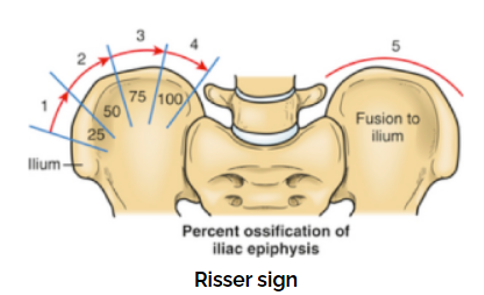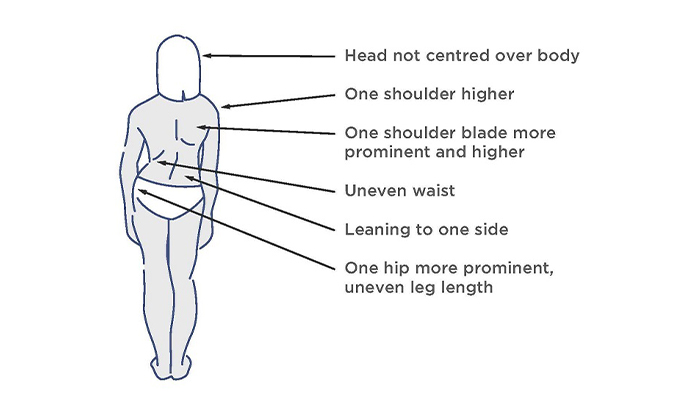
IMAGE CREDIT: vsrc.com.au
16 November 2022
The Risser scale (named after Dr Joseph C. Risser) is a measurement of skeletal maturity or growth; it utilizes the fact that as a person’s skeleton matures during adolescence bone starts to form on the outer part of the iliac crest (upper edge of the pelvis) and calcifies inward along the ridge. After this bone formation is complete, the new bone growth fuses to the hip bone and this fusion are believed to correspond with full skeletal maturity. So, the degree of bone growth can be used to determine what stage of skeletal maturity has been reached.
Conveniently the same X-ray that is taken to measure a patient’s Cobb angle can be used to determine this. A scale of 0-5 is used where Risser 0 shows a significant amount of growth is still to happen while Risser 5 indicates full skeletal maturity.
Using the information below one can determine the Stage a patient has reached.
Risser 1 typically equates to the beginning of puberty, 3 is normally around mid-puberty and 5 is a fully grown adult. Boys and girls start puberty at different ages which normally means they finish at different ages. With girls normally starting at 11-12 and finishing at 16-17 and boys starting at 12-13 and finishing at 17-18.
So why is the Risser scale an important consideration in scoliosis treatment?
With LOC’s Scoliosis brace, the main goal is to correct the curve by straightening the spine and holding it in place. Normally with scoliosis patients, their vertebrae are compressed asymmetrically, and this inhibits growth on one side while not inhibiting growth on the other.
This leads to a wedging effect which is shown in their growth pattern which can potentially lead to an increase in Cobb angle and further curvature of the spine.in the back. By straightening the spine and holding it in position, we correct this asymmetric weight distribution and encourage a more balanced growth pattern.
This is facilitated within LOC’s Scoliosis brace, but the patient needs to grow in this new position. Therefore, the more potential growth to the patient (as denoted by how low the patient is on the Risser scale) means that more growth is possible in the corrected position. We can then anticipate more correction throughout treatment until Risser stage 4 or 5 has been reached. LOC normally advises patients to wear their scoliosis braces for 22-23 hours a day (described as full-time wear) as the more time they are held in this corrected position the more time they grow in this position, and thus more correction will be achieved.
If your child has recently been diagnosed with scoliosis we can advise where your child is on the Risser scale and therefore whether our non-surgical treatment is appropriate or not. Please contact us
Especially in young people, spotting the early signs of scoliosis is important – as is seeking early treatment. These are the warning signs to look out for:

Visual signs of Scoliosis
You can find out more about the visual signs of scoliosis here.
Find out more information about the LOC Scoliosis Brace
If you think your child, adolescent or adult family member has scoliosis, you can contact LOC directly to arrange a consultation at one of our scoliosis clinics.
If your child has recently been diagnosed with Scoliosis or you think they are showing signs of the condition, please contact us
The operation used to treat severe scoliosis curves is typically spinal fusion surgery; a major procedure that involves moving muscles and realigning the skeleton into place. The curved, deformed vertebrae are fused together into a single bone, putting metal screws and rods into the spine to help straighten it. Surgery typically lasts between 4 and 8 hours depending on the severity of the curve. Bone graft is then taken from other parts of the body and used to cover the implants.
Following the operation, it is necessary to spend around a week in intensive care before returning home and the first few days are often uncomfortable. Most adolescents can expect to return to school from 2-4 weeks following surgery, but pain medication may be required up to 6 weeks following. A full recovery from the procedure can take up to a year, as it can take that long for the spine to heal fully.
Spinal fusion surgery causes the fused portion of the back to become permanently stiff, as a result, returning to sports that require large amounts of flexibility (ballet, yoga, gymnastics, dance) or contact (rugby, football, karate, hockey) may take longer.
Risks of spinal fusion surgery are like that of any other major procedure and include infection, blood clots and anaesthesia complications. The added risks include permanent nerve damage to the spine and paralysis.